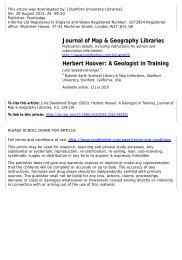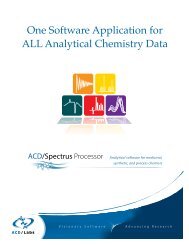SNIA's Cloud Archive & Cloud Data Management Interface
SNIA's Cloud Archive & Cloud Data Management Interface
SNIA's Cloud Archive & Cloud Data Management Interface
You also want an ePaper? Increase the reach of your titles
YUMPU automatically turns print PDFs into web optimized ePapers that Google loves.
Storage and <strong>Data</strong> <strong>Management</strong> in a<br />
post-Filesystem PRESENTATION TITLE GOES World HERE<br />
Preservation and <strong>Archive</strong> SIG<br />
Austin, TX<br />
January 2012<br />
<strong>Cloud</strong> Storage
<strong>Data</strong> Storage <strong>Interface</strong> Evolution<br />
<strong>Cloud</strong> Storage<br />
! Born Digital data is being generated by an ever diversifying set<br />
of devices<br />
! 75% of data being generated by individuals (IDC)<br />
! Amount of <strong>Data</strong> doubling every two years<br />
! 5 Billion Mobile Phones<br />
! Tablets on the rise<br />
! Storage space on devices will always be limited (although<br />
continues to grow exponentially)<br />
! Device Apps are accessing content/storage via the Internet<br />
! <strong>Cloud</strong> Storage largely driven by device based use cases<br />
! Traditional data storage interfaces (filesystems) are not up to<br />
this task!
Distilled Requirements<br />
! Need a Global Namespace for data location<br />
! FILE handle -> URL + Unique Object ID globally<br />
! Need support for Rich Metadata associated with the data<br />
! Plus Metadata Query and Index based Search<br />
! Need HTTP access – browser support<br />
! <strong>Data</strong> Services need to be transparent to the user, but<br />
extensible and powerful<br />
! Driven by Metadata<br />
! Support for large objects<br />
! Support for active preservation operations<br />
! Driven by preservation Metadata<br />
<strong>Cloud</strong> Storage
Post-Filesystem <strong>Data</strong> Storage<br />
<strong>Cloud</strong> Storage<br />
! The SNIA has produced the <strong>Cloud</strong> <strong>Data</strong> <strong>Management</strong><br />
<strong>Interface</strong> (CDMI) standard for post-Filesystem <strong>Data</strong> Storage<br />
! i.e. Public and Private/Hybrid Storage <strong>Cloud</strong>s<br />
! Specifically designed to meet the requirements (for the<br />
foreseeable future) of contemporary data usage and<br />
management<br />
! Superset of features currently being offered, but “shrink to fit”<br />
! Innovative use of Metadata to express “<strong>Data</strong> Requirements”<br />
! Requirements are then met by the implemented <strong>Data</strong> Services<br />
! CDMI can be (and is being) extended compatibly<br />
! To accommodate new types of data requirements, use cases
Where is it being used?<br />
! Commercial <strong>Cloud</strong> Storage vendors started announcing<br />
implementations in April 2011<br />
<strong>Cloud</strong> Storage<br />
! Increasing Adoption by eScience and Academic community<br />
! Especially in Europe (OpenNebula open source cloud, others)<br />
! Quarterly Plugfests with growing participation<br />
! > 30 participants – Dusseldorf, Germany February 2012<br />
! CDMI 1.0.1 on it’s way to International Standard status<br />
! JTC 1 PAS submission ballot underway<br />
! CDMI has a reference implementation (Java under BSD)<br />
! Downloaded by hundreds of developers worldwide
CDMI Overview<br />
! <strong>Data</strong> Portability Standard<br />
<strong>Cloud</strong> Storage<br />
! Move <strong>Data</strong> (and most importantly – Metadata) from cloud to cloud<br />
! Advanced <strong>Cloud</strong> Services<br />
! <strong>Data</strong> System Metadata allows cloud vendors to up-sell!<br />
! Specialized storage clouds for specific use cases<br />
! Logging, Security, Audit Trails<br />
! Extensible to accommodate rapid innovation in cloud market<br />
! Proposed Extensions: CIMI/OVF, Versioning, Jobs<br />
! Shrink-to-fit<br />
! Only implement what makes sense for your cloud<br />
! Profiles: Simple Storage (i.e. S3), Simple Storage <strong>Management</strong> (NAS)<br />
6
The Complete Picture<br />
<strong>Cloud</strong> Storage<br />
8
<strong>Cloud</strong> Peering<br />
<strong>Cloud</strong> Storage<br />
9
CDMI Overview<br />
<strong>Cloud</strong> Storage<br />
r CDMI Basic flow:<br />
10
Model for the <strong>Interface</strong><br />
The resources which are accessed through the RESTful interface<br />
<strong>Cloud</strong> Storage<br />
11
Leveraging the Storage Industry Resource Domain Model<br />
<strong>Cloud</strong> Storage<br />
All of these interfaces support some or all of this model. The key to retaining<br />
the simplicity of the cloud, however, is in the use of metadata to drive the<br />
underlying services so that users need not manage the services themselves.<br />
12
<strong>Data</strong> System Metadata drives <strong>Data</strong> Services<br />
<strong>Cloud</strong> Storage<br />
! Policies of the form IF THEN <br />
! <strong>Data</strong> System Metadata part of the side of <strong>Data</strong><br />
Policies<br />
! <strong>Data</strong> Services are invoked as part of the side<br />
! Standard <strong>Data</strong> System Metadata can be extended<br />
! Additional <strong>Data</strong> Services can be added over time<br />
! Offerings can offer any combination of data services for their<br />
customers<br />
! Discovered through CDMI Capabilities<br />
! CDMI query and queues can be used by add-in <strong>Data</strong> Services<br />
! FP7 project VISION <strong>Cloud</strong> using this approach - “active storage”<br />
! Java based “storelets” can be uploaded to the cloud and activated
Domains of Resource <strong>Management</strong><br />
<strong>Cloud</strong> Storage<br />
14
Self-contained Information<br />
Retention Format (SIRF)<br />
An Analogy<br />
! Standard physical archival box<br />
! Archivists gather together a group of related items and place<br />
them in a physical box container<br />
! The box is labeled with information about its content e.g.,<br />
name and reference number, date, contents description,<br />
destroy date<br />
! SIRF is the digital equivalent<br />
! Logical container for a set of (digital) preservation objects<br />
and a catalog<br />
! The SIRF catalog contains metadata related to the entire<br />
contents of the container as well as to the individual objects<br />
! SIRF standardizes the information in the catalog<br />
<strong>Cloud</strong> Storage<br />
Being developed by Storage Networking Industry Association (SNIA), Long Term Retention<br />
(LTR), Technical Working Group (TWG)<br />
Photo courtesy Oregon State <strong>Archive</strong>s
SIRF Components<br />
A SIRF container includes:<br />
! A magic object: identifies<br />
SIRF container and its version<br />
! Numerous preservation<br />
objects that are immutable<br />
! A catalog that is<br />
! Updatable<br />
! Contains metadata to make<br />
container and preservation objects<br />
portable into the future without<br />
external functions<br />
<strong>Cloud</strong> Storage<br />
16
SIRF and CDMI<br />
<strong>Cloud</strong> Storage<br />
! <strong>Cloud</strong> <strong>Data</strong> <strong>Management</strong> <strong>Interface</strong> (CDMI) specifies a standard API for<br />
clouds<br />
! CDMI API can be used to access the various preservation objects and the<br />
catalog object in a SIRF-compliant container<br />
! Example<br />
! Assume we have a cloud container named "PatientContainer" that is SIRFcompliant<br />
! each encounter is a preservation object<br />
! each image is a preservation object<br />
! the container has a catalog object<br />
PO Patient<br />
Container<br />
! We can read the various preservation objects and the catalog object via CDMI<br />
REST API as follows:<br />
GET //encounterJan2001<br />
GET //chestImage<br />
GET / PatientContainer>/catalog<br />
PO<br />
cat<br />
PO
Future feature candidates for CDMI<br />
! CDMI Profiles (may be done ancillary to<br />
specification)<br />
! Simple Storage <strong>Management</strong><br />
! Simple Storage<br />
! CDMI Extensions:<br />
! Multi-part MIME GET/PUT<br />
! Key/Value Store support (i.e. NoSQL)<br />
! CDMI Jobs<br />
! Versioning<br />
<strong>Cloud</strong> Storage
CIMI/OVF Support Specifics<br />
! Add a new capability: cdmi_ovf_support<br />
<strong>Cloud</strong> Storage<br />
! If present and true, OVF files can be the source of a container create<br />
! Create a container with an OVF file<br />
! application/ovf mime type CDMI Object<br />
! JSON String<br />
! A data object serialized as an OVF file as specified in [OVF 1.1]<br />
! Result is a Container with exportable sub-containers and data<br />
objects corresponding to each file in the archive<br />
! Works with proposed OVF extension to CIMI<br />
! VirtualSystemCollection maps to CIMI System class<br />
! DiskSection of OVF maps to CIMI Volumes/CDMI exported<br />
containers
Example CDMI Extension: CIMI/OVF<br />
! IaaS cloud<br />
implements<br />
multiple cloud<br />
standards: CIMI,<br />
OVF, CDMI<br />
! Orchestration<br />
layer implements<br />
the support<br />
! Client uses each<br />
API for respective<br />
tasks: cloud<br />
computing, cloud<br />
storage, portability<br />
<strong>Cloud</strong> Storage
CDMI Profiles<br />
<strong>Cloud</strong> Storage<br />
! Profiles are a means of “scoping down” CDMI for specific use<br />
cases<br />
! Clients can then depend on certain CDMI features being<br />
available if an implementation claims profile conformance<br />
! Profile consists of:<br />
! Profile use case description (descriptive text and diagrams)<br />
! List of required and optional CDMI capabilities that make up the<br />
profile<br />
! “Programmers Guide” examples of using the profile from a client’s<br />
perspective (to encourage client side adoption of the profile as well)<br />
! Profiles intended to drive conformance programs
CDMI Profile: Simple Storage <strong>Management</strong><br />
<strong>Cloud</strong> Storage<br />
! Many storage vendors have products that are sold with<br />
private management interfaces for the storage administrator<br />
! They are looking for a self service RESTful API they can easily<br />
add to their products for cloud storage provisioning and data<br />
management<br />
! <strong>Cloud</strong> Storage Administrator sets up pools of storage of<br />
different types: i.e. Gold, Silver, Bronze<br />
! Each with different capabilities exposed through CDMI<br />
! <strong>Cloud</strong> Storage User picks a storage type and creates<br />
Containers, exporting them via iSCSI, NFS, CIFS, etc.<br />
! Charge back is possible to the various departments for their use
CDMI Profile: Simple Storage<br />
<strong>Cloud</strong> Storage<br />
! Many storage vendors are looking for a RESTful object<br />
storage data path to enable (alongside existing interfaces such<br />
as NFS and iSCSI)<br />
! CDMI can be used as such a data path<br />
! The Simple Storage Profile describes using CDMI for the<br />
subset of capabilities that match the typical data path offering<br />
! i.e. Amazon S3, Rackspace <strong>Cloud</strong> Files, Nirvanix, etc.<br />
! CDMI allows interoperability without having to reverse<br />
engineer a de facto (under specified) API<br />
! Implementations can be done from the profile document itself<br />
with only occasionally referring to the CDMI spec itself
CDMI Capabilities<br />
! How do you know what your cloud can do?<br />
<strong>Cloud</strong> Storage
<strong>Data</strong> System Metadata Capabilities<br />
! cdmi_value_hash<br />
<strong>Cloud</strong> Storage<br />
! This metadata is used to indicate if the object data is to be hashed and<br />
indicates the desired hash algorithm and length. Supported algorithm/<br />
length values are provided by the cdmi_value_hash capability.<br />
! cdmi_latency<br />
! If present and "true", indicates that the cloud storage system shall tier<br />
data based on desired latency. If absent, the max latency specified shall<br />
be ignored.<br />
! cdmi_throughput<br />
! If present and "true", indicates that the cloud storage system shall tier<br />
data based on desired throughput. If absent, the max throughput<br />
specified shall be ignored.
How does CDMI fit into a storage cloud?<br />
<strong>Cloud</strong> Storage<br />
! Large Scale out <strong>Cloud</strong><br />
! Deployed as a horizontal set of parallel filesystem clients with requests<br />
balanced across them<br />
! Storage is implemented by a set of data servers with a common<br />
metadata server<br />
31
For More information<br />
! One Web Site to Remember:<br />
http://snia.org/cloud<br />
! Online Version of CDMI:<br />
http://cdmi.sniacloud.com<br />
! Offline questions:<br />
mark.carlson@oracle.com<br />
<strong>Cloud</strong> Storage<br />
32
















